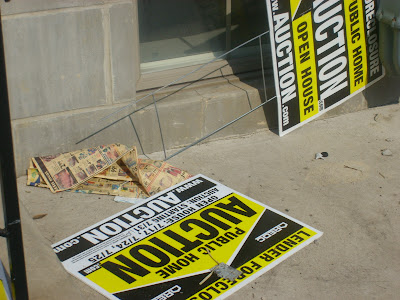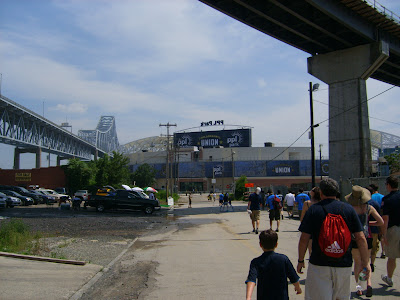
For a city of its size, there isn't really an iconic view of the Philadelphia Skyline. We don't have "the" view, in the way that New York has Lower Manhattan on postcards everywhere. There are many possible reasons for this, but I think that a big one is logistical- it's not easy to view the whole city at once. Long views are often taken from the water, but we don't have an Ocean, a Bay, or a Great Lake at our disposal. The Delaware River, as we know all too well, is too much of a commercial waterway to really be useful here. Coming in on the train from the NE corridor is picturesque and flattering, but the view only lasts for a few seconds before you are sucked underground. Philly also doesn't have a skyscraper lookout point, either- the highest publicly accessible location is still City Hall.
 Don't look down
Don't look downIn this context, then, the extreme popularity of roofdecks makes a lot of sense. I am not one of lucky (yet), but I was up on my rowhouse roof last week, and was stunned by what I saw. From 3 stories up in G-Ho, er SWCC, er...Fake South Philly, I could see all the way from river to river, and a little of UCity, as well.
Society Hill Towers (right background) and the Pepto Bismol condo :

To the Drake and the Rittenhouse Skyline:

The West Market Skyscrapers:

Perelmen Center for Advanced Medicine:
 Endless rowhome roofs:
Endless rowhome roofs: And finally, my block.
And finally, my block.
Of all these, the West Market view is probably my favorite. It contains all of the city's tallest buildings, and catches them at a diagonal angle, giving the skyline some depth (as opposed to the famous view from the East, which seems "flat" to me, like set dominoes).
Photographers may recognize this as the unavailable "South Street Bridge View", as well. For another few months, the tops of our own houses are the best replacement.






 Don't look down
Don't look down


 Western side
Western side city skyline
city skyline I-76 bridge
I-76 bridge the banks below
the banks below



 in 2007
in 2007 In 1960
In 1960


















